Albuquerque Basin
The Albuquerque Basin (or Middle Rio Grande Basin[1]) is a structural basin within the Rio Grande rift in central New Mexico. It contains the city of Albuquerque.
| Albuquerque Basin | |
|---|---|
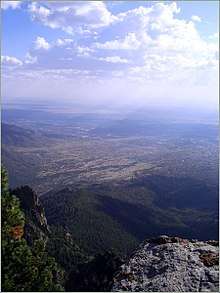 View of the Albuquerque Basin from Sandia Peak | |
| Type | Structural basin |
| Unit of | Rio Grande rift |
| Location | |
| Coordinates | 35.10°N 106.60°W |
| Country | |
 | |
Geologically, the Albuquerque Basin is a half-graben that slopes down towards the east to terminate on the Sandia and Manzano mountains.[2] The basin is the largest and oldest of the three major basins in the Rio Grande rift,[3] with a depth ranging from 4,407 to 6,592 metres (14,459 to 21,627 ft).[4]
The basin has a semi-arid climate, with large areas that count as desert.[1] Paleo-Indian traces dating back 12,000 years show that the climate used to be wetter and more fertile than it is today.[5] The Rio Grande flows through the basin from north to south, and its valley has been irrigated for at least 1,000 years.[6] Intense irrigation began in the late nineteenth century with new dams, levees and ditches and has caused environmental problems.[7]
In times of low water levels in the Rio Grande, Albuquerque relies on groundwater for its potable water supply. The aquifer is composed of deposits from the ancestral Rio Grande and the size of its annual recharge follows fluctuations in weather and climate phenomena.[4] There may be natural gas in the basin, but opponents to production fear the impact on the groundwater and on the quality of life.[8]
Location

The Albuquerque Basin covers 8,000 square kilometres (3,100 sq mi) of New Mexico.[4] The basin is bounded by the Sandia and Manzano mountains on the east, the Jemez Mountains to the north, the Rio Puerco on the west and the Socorro Basin to the south.[8] It is 160 kilometres (99 mi) north-south and 86 kilometres (53 mi) east-west at its widest point.[3] The Rio Grande, at an elevation of 1,420 metres (4,660 ft) runs through the basin from north to south. To the east, alluvial fans and stream terraces descend to the river from the mountains that form the eastern boundary of the basin. West of the river the Llano de Albuquerque contains only isolated mountains and volcanoes, sloping gradually up to the Rio Puerco. Throughout the basin, which receives little rainfall, there are sand dunes and dune fields, some vegetated and some active.[1]
The basin is rich in Paleo-Indian sites, most of which are found on terraces or other uplands near to the Rio Grande.[5] Some of the sites date back 12,000 years from the present.[9] During the period of Paleo-Indian occupation the playas (dry lake basins) contained wetlands with more vegetation than in today's dry conditions.[5] Remains of the Folsom people include flaked stone tools, pottery sherds and the bones of bison.[10]
Modern communities in the hydrological basin[lower-alpha 1] include, from north to south, Cochiti, Santo Domingo, San Felipe, Algodones, Bernalillo, Rio Rancho, Albuquerque, Isleta, Los Lunas, Belen and Bernardo.[11]
Geology
The Albuquerque basin is the largest and oldest of the three major basins in the Rio Grande rift.[3] The depth of the basin typically ranges from 4,407 to 6,592 metres (14,459 to 21,627 ft).[4] The Santa Fe group deposits accumulated in the basin between the middle Miocene and early Pliocene, from fifteen to one million years ago. Alluvial sediment came from the adjacent highlands and fluvial sediments came from southern Colorado and northern New Mexico.[12]
During the Middle to Late Miocene era the Albuquerque and Espanola basins formed one basin, an irregular half-graben tilting west, formed by high-angle faulting on reactivated structures from the Laramide orogeny. The Embudo-Pajarito-La Bajada-San Francisco-Rincon fault system became active at the end of the Miocene. When this happened, the Albuquerque basin reversed its half-graben tilt from west to east, and now slopes down to the base of the newly formed Sandia Mountains.[13]
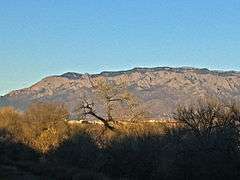
A model of the basin based on seismic reflection data gathered by the oil industry was published in the early 1990s. In this model, the northern part of the basin was an east-tilted half graben, while the southern portion was a west-tilted half graben. A transfer zone running in a southwest direction connected the two. More recently, gravity data has given support for a different model, which is consistent with other sources of information. In this new model, the northern portion is an ENE-facing half-graben, extending further east than had been thought, while the southern portion is an east-facing half graben. The two are connected by a structural high running in a northwest direction. There is a west-tilting area in the southwestern margin of the basin, but it is just 15 to 30 kilometres (9.3 to 18.6 mi) wide.[2]
There were volcanic eruptions throughout the period while the Santa Fe Group sediments were being deposited, and these continued into the late Pleistocene. Most of the resulting basalt and andesite rock is on the west side of the basin.[14] The Albuquerque volcanic field contains volcanoes to the west of the city of Albuquerque that were active as recently as 156,000 years ago. The surface of the basin has extensive wind-blown deposits of sand sheets and dunes from the late Pleistocene and Holocene.[15]
Climate
The climate is semi-arid.[16] A large part of the basin is so dry as to be considered a desert.[1] Average annual temperatures are around 13 °C (55 °F), ranging from an average of about 1 °C (34 °F) in January to about 24 °C (75 °F) in July. Average annual rainfall ranges from 190 millimetres (7.5 in) at Belen to 760 millimetres (30 in) at Sandia Crest.[17] Precipitation comes from local thunderstorms in summer and from storm fronts in winter. The amount of rain that falls in a given year or place in the basin is unpredictable. Droughts lasting several years are not unusual. Throughout the basin, potential evapotranspiration is much higher than rainfall, meaning the ground is dry most of the time unless it is irrigated. Vegetation includes desert scrub and grassland in the lower levels, riparian woodland (bosque) along the Rio Grande, and woods on the mountain slopes.[16]
Surface water
The Rio Grande, which flows from southwestern Colorado for 2,000 kilometres (1,200 mi) before entering the Gulf of Mexico, was classified in 1993 as one of North America's most endangered or imperiled rivers. The Rio Grande flows south into the Albuquerque Basin between the Sandia and Jemez mountains. Before entering the basin the river is impounded by the Cochiti Dam, built in 1975. After leaving the basin via Socorro, the river is impounded by the Elephant Butte Reservoir, built in 1916. Within the stretch between these dams, the river passes three mainstream structures that divert water into 1,280 kilometres (800 mi) of levees, canals and drains in the section between Algodones and the Bosque del Apache National Wildlife Refuge. When the river is low, the diversion dams at Isleta and San Acacia can divert all water from the Rio Grande along a 177 kilometres (110 mi) stretch of the river.[18] Tributaries include the Jemez River and Rio Puerco from the west, and the Santa Fe River and Galisteo Creek from the east.[11]
The Pueblo people of the Rio Grande valley had developed primitive irrigation systems by the 10th century AD, and by the 13th century most of the major pueblos had been established.[6] The Pueblo system of irrigation ditches is one of the oldest of the irrigation systems in North America.[19] These systems used a main acequia (shared irrigation ditch) into which water was diverted from the river, with secondary ditches leading off the main channel named for specific families. Maintenance of the main acequia would be a community responsibility.[20] The Spanish arrived in New Mexico in 1598, and steadily expanded their presence, founding Albuquerque in 1706.[6] The Spanish used Indian labor to extend the system of irrigation ditches. Again, once a community grew large enough they would form a community association to look after maintenance.[20] The Spanish were familiar with Moorish irrigation techniques, and may have adapted them to the canals that had been built by the Pueblos.[19]
In 1848 Mexico ceded the territory to the United States. Railways arrived in 1880, bringing Anglo settlers.[6] The federal government encouraged more irrigation, which probably peaked in the early 1890s.[21] The newcomers developed the vineyards, orchards and vegetable farms, and by 1900 were exporting produce as far as California.[19] Over-exploitation caused a steady decline in irrigation due to "droughts, sedimentation, aggradation of the main channel, salinization, seepage and waterlogging".[21] The acequia running through the city of Albuquerque, parallel to the river, became an unsanitary drainage ditch, serving as a common sewer.[22]
In 1925 the Middle Rio Grande Conservancy District (MRGCD) was formed. It built a levee to reduce the impact of Rio Grande floods, drained the swampy land and improved the acequias.[19] During and after World War II, the city of Albuquerque has grown steadily.[6] The MSGCD still maintains a large network of canals and irrigation systems that stretches from 30 miles (48 km) north of Albuquerque through the city down to the Bosque del Apache National Wildlife Refuge.[23] As of 2012 the MRGCD was responsible for an area of 278,000 acres (113,000 ha), of which 128,787 acres (52,118 ha) could be irrigated and 70,000 acres (28,000 ha) were in fact being irrigated by 11,000 farmers. The MRGCD was maintaining four diversion dams and reservoirs, 834 miles (1,342 km) of canals and ditches and 404 miles (650 km) of riverside drains. With growing urbanization, the role of the MRGCD has gradually shifted from supporting agriculture to preserving the riverside ecology and helping to recharge the Albuquerque aquifer.[24]
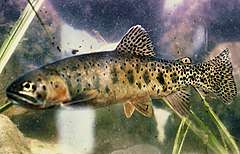
The Rio Grande in the Albuquerque basin had a diverse population of mainly endemic fish up to the late nineteenth century. By the early 1960s many of the native species were no longer present in the northern part of the basin. Speckled chub and Rio Grande bluntnose shiner, two cyprinids, were last found in 1964. By the mid-1990s 45 species of fish were reported in the basin, of which only 17 were native.[18] More than 40% of the native species of this section of the river have been eliminated. The main threats to the fish are diversion and pumping of water. River volumes peak between March and June due to the spring runoff, but demand for irrigation peaks between July and October. During the irrigation period, the river downstream from the Isleta diversion dam may largely dry up unless irrigation water is returned to the river or a summer storm provides a brief influx of water.[25] Native fish may be trapped in pools in the river bed, where introduced game fish may take them, or they may die from loss of water in which they can live.[7] The river may not start running steadily until the end of October, when irrigation stops.[25]
Groundwater
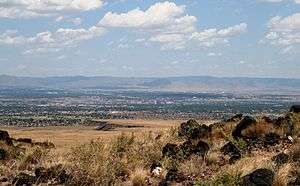
Settlements in the region depend on groundwater. In the 1960s the City of Albuquerque began to extract large quantities of potable groundwater from wells drilled in the southeast and northeast heights. It was thought that this water came from a huge aquifer that would take centuries to exhaust. In the late 1980s there were declines in the water levels near Coronado Center causing concern that the water resource was not properly understood. Since 1992 the New Mexico Bureau of Geology and Mineral Resources has been undertaking extensive investigations of the geology of the basin and the aquifer.[4]
The groundwater has been deposited in three main phases. The lower Santa Fe group was created by dune fields and small streams draining into playa lakes and mud flats. The sediments in this group yield low volumes of poor quality water. Deposits in the upper Santa Fe group come from drainage of the ancestral Rio Grande and the tributaries of that river. Although a small part of the total, most of the potable water in the region comes from these later deposits, which lie within 2 kilometres (1.2 mi) of the eastern boundary of the basin. Finally, the modern Rio Grande cut down into the Santa Fe group sediments to create the present river valley.[26]
In the last 10,000 to 15,000 years the river valley has been receiving more sediment than it can carry away, building as much as 61 metres (200 ft) of new fill.[12] There is groundwater in this new fill, which forms a thin aquifer very close to the surface and therefore very susceptible to contamination. Extraction of water from the valley floor aquifer is likely to cause subsidence and damage to buildings.[26]
Oil and gas
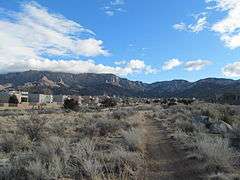
Other basins in the Santa Fe rift hold oil and gas, which has been found in small quantities in wells east of Española and southwest of Santa Fe.[8] The first known well to be drilled in the Albuquerque Basin in search of oil and gas was in 1914, and since then at least fifty exploratory wells have been drilled. Before 1953 most of these wells were shallow and only reached into the Tertiary deposits, but found numerous shows of oil and gas. After 1953 most of the wells were deeper, probing the Cretaceous deposits below the Tertiary fill. Royal Dutch Shell and other companies drilled wells in the 1970s and 1980s, mostly from 11,000 to 14,000 feet (3,400 to 4,300 m) deep. They found gas in the Cretaceous rocks, but not in commercial quantities. Exploration was halted in the late 1980s and early 1990s due to low global oil prices.[27]
In 2001 the U.S. Geological Survey published a report on the probability that gas would be found in the basin. It noted that the Albuquerque Basin, like other basins formed during the Laramide orogeny, contains a thick layer of coals, carbonaceous shales and marine shales from the Cretaceous era. These are thought to be the source of basin-centered accumulations of gas. Unlike other basins in the region, the Albuquerque Basin is still actively subsiding. The temperature and pressure on the hydrocarbon source rocks in the deeper parts of the basin will be causing gas to generate, and the gas is probably migrating upward and accumulating in Upper Cretaceous sandstones. After discussing other factors, the report concluded "All of these characteristics suggest that a basin-centered gas accumulation of some sort is present in the Albuquerque Basin."[28]
In 2007-2008 the Houston-based Tecton Energy had obtained the mineral rights to about 50,000 acres (20,000 ha) owned by SunCal, and had been exploring for natural gas on the Southwest Mesa. About 46 test wells had been drilled in the basin. Plans to exploit gas were opposed by activists concerned about damage to groundwater and to the environment if exploitation were allowed. In January 2008 Governor Bill Richardson imposed a six-month moratorium on further exploration.[8]

References
Notes
- The boundaries of the geological basin and the hydrological basin are close but not exactly the same, and different sources disagree on the precise boundaries.
Citations
- Bartolino & Cole 2002, p. 9.
- U.S. Geological Survey 2011.
- Russell & Snelson 1994, pp. 83-112.
- Albuquerque Basin - NM Tech.
- Holliday et al. 2006, p. 765.
- Bartolino & Cole 2002, p. 16-17.
- Finch & Tainter 1995, p. 169.
- Scarantino 2008.
- Holliday et al. 2006, p. 778.
- Holliday et al. 2006, p. 777.
- Major physiographic and hydrologic features...
- Finch & Tainter 1995, p. 54.
- Large & Ingersoll 1997, p. 462.
- Holliday et al. 2006, p. 767.
- Holliday et al. 2006, p. 769.
- Bartolino & Cole 2002, p. 14.
- Bartolino & Cole 2002, p. 11.
- Finch & Tainter 1995, p. 165.
- Price 1992, p. 91.
- Lazell & Payne 2007, p. 12.
- Bartolino & Cole 2002, p. 17.
- Lazell & Payne 2007, p. 36.
- Price 1992, p. 92.
- Gardner 2012, p. 164.
- Finch & Tainter 1995, p. 168.
- Connell 2012.
- Johnson, Finn & Nuccio 2001, p. 5.
- Johnson, Finn & Nuccio 2001, p. 1.
Sources
- "Albuquerque Basin". The New Mexico Bureau of Geology & Mineral Resources. Archived from the original on 2014-04-24. Retrieved 2014-04-23.
- Bartolino, James R.; Cole, James C. (2002). Ground-water resources of the Middle Rio Grande Basin, New Mexico. U.S. Dept. of the Interior, U.S. Geological Survey. p. 124. ISBN 978-0607989908. Retrieved 2012-09-28.CS1 maint: ref=harv (link)
- Connell, Sean D. (2012). "GEOLOGY, GROUNDWATER, AND GEOLOGIC HAZARDS IN THE ALBUQUERQUE BASIN, NEW MEXICO" (PDF). New Mexico Bureau of Geology and Mineral Resources. Retrieved 2012-09-28.CS1 maint: ref=harv (link)
- Finch, Deborah M.; Tainter, Joseph A. (1995). Ecology, Diversity, and Sustainability of the Middle Rio Grande Basin. DIANE Publishing. p. 54. ISBN 978-0-7881-3013-7. Retrieved 2012-09-28.CS1 maint: ref=harv (link)
- Gardner, B. Delworth (2012-04-30). Aquanomics: Water Markets and the Environment. Transaction Publishers. p. 164. ISBN 978-1-4128-4269-3. Retrieved 2012-09-29.CS1 maint: ref=harv (link)
- Holliday, Vance T.; Huckell, Bruce B.; Mayer, James H.; Forman, Steven L.; McFadden, Leslie D. (2006). "Geoarchaeology of the Boca Negra Wash Area, Albuquerque Basin, New Mexico, USA" (PDF). Geoarchaeology. Wiley Periodicals, Inc. 21 (8): 756–802. doi:10.1002/gea.20139. Archived from the original (PDF) on 2013-11-03. Retrieved 2012-09-28.CS1 maint: ref=harv (link)
- Johnson, Ronald C.; Finn, Thomas M.; Nuccio, Vito F. (July 2001). "Potential for a Basin-Centered Gas Accumulation in the Albuquerque Basin, New Mexico" (PDF). U.S. Department of the Interior - U.S. Geological Survey. Retrieved 2012-09-28.CS1 maint: ref=harv (link)
- Large, Elizabeth; Ingersoll, Raymond V. (May 1997). "Miocene and Pliocene sandstone petrofacies of the northern Albuquerque Basin, New Mexico, and implications for evolution of the Rio Grande Rift". Journal of Sedimentary Research. 67 (3). doi:10.1306/d426859a-2b26-11d7-8648000102c1865d. Retrieved 2012-09-28.CS1 maint: ref=harv (link)
- Lazell, Carleen; Payne, Melissa (2007-01-01). Historic Albuquerque: An Illustrated History. HPN Books. ISBN 978-1-893619-75-3. Retrieved 2012-09-29.CS1 maint: ref=harv (link)
- "Major physiographic and hydrologic features of the Middle Rio Grande". U.S. Geological Survey. Retrieved 2012-09-30.
- Price, Vincent Barrett (1992). Albuquerque: A City at the End of the World. UNM Press. p. 91. ISBN 978-0-8263-3097-0. Retrieved 2012-09-29.CS1 maint: ref=harv (link)
- Russell, L.; Snelson, S. (1994). Structure and tectonics of the Albuquerque basin segment of the Rio Grande Rift: Insights from reflection seismic data. Geological Society of America Special Paper 291. ISBN 0-8137-2291-8.CS1 maint: ref=harv (link)
- Scarantino, Jim (6 February 2008). "Drilling Albuquerque - Our future in the oil patch?". Alibi. Retrieved 2012-09-28.CS1 maint: ref=harv (link)
- U.S. Geological Survey (10 March 2011). "Middle Rio Grande Basin Geophysics - 3D Model of the Albuquerque Basin". U.S. Department of the Interior. Retrieved 2012-09-28.CS1 maint: ref=harv (link)